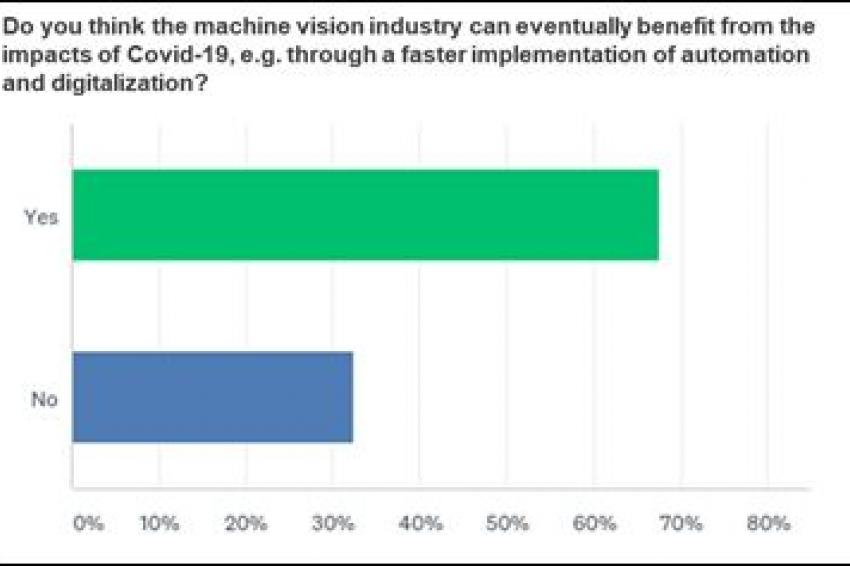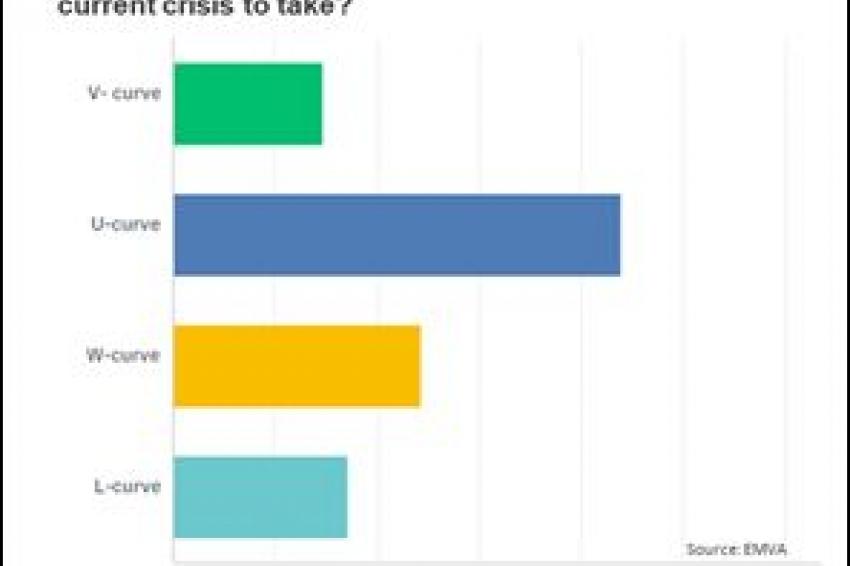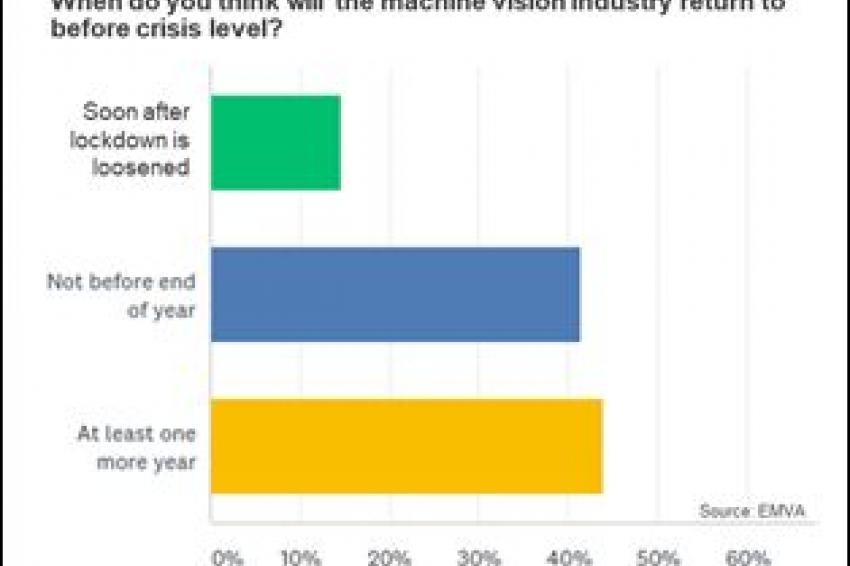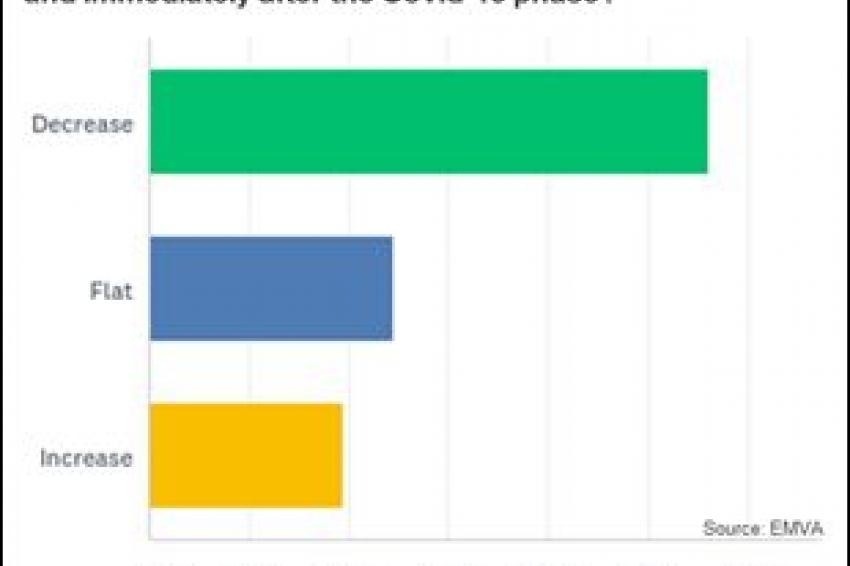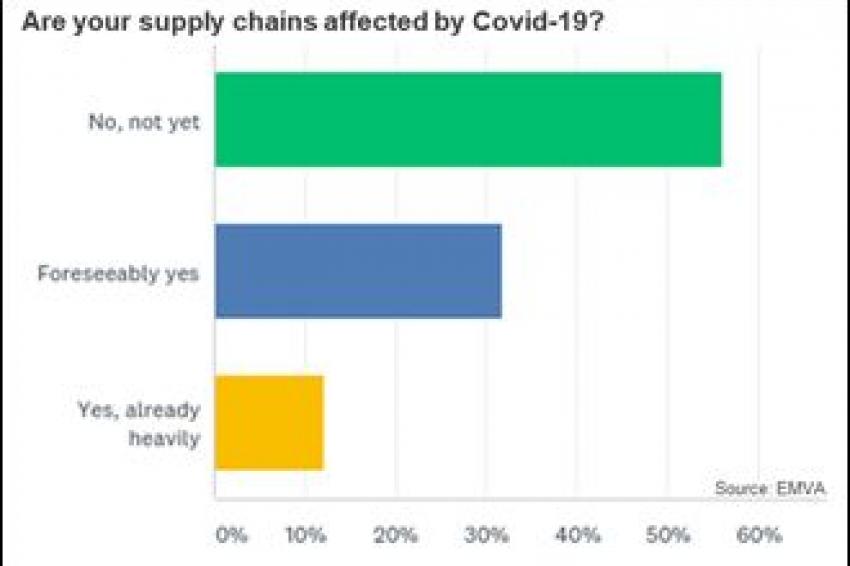EMVA survey: Sales collapse by 17 percent in 2020
Effects of the Corona crisis on the machine vision industry
During April and June 2020, the EMVA conducted a bipartite survey on the effects of the Covid-19 crisis for the machine vision industry. A standardized questionnaire was distributed by email to a wide range of industry participants, both EMVA member companies and from the wider industry. On average the survey participants anticipate the machine vision industry to contract by 17% in 2020.
At the time the answers were provided, the impacts of the Covid-19 pandemic were not yet consistently severe across the world. However a dominant concern which emerged in the machine vision industry was about future economic development. Almost 44% of the answers to the questions about which overall economic development the Corona situation will take, anticipated a U-curve with a strong economic decline, a lasting period of recession with only then at the end a strong recovery. 24% indicated a double-dip W-recession caused by firstly catch-up investments after the lockdown followed by a slow-down due to missing order income during the lockdown period; and a possible threat of a second Coronavirus infection wave. 17% expect a strong decline with no signs of fast recovery (L-curve); and only some 15%, believe in a strong and fast recovery after the sharp recession (V-curve).
Stronger corona effects expected in H2 2020
This lack of trust in a quick and fast recovery is reinforced by many opinions gathered in the direct interviews, and also by the results of another EMVA survey, the continuous EMVA Quarterly Machine Vision Sales Report. That survey saw the machine vision industry already contracting in the fourth quarter of 2019 and first quarter of 2020 and expectations of much stronger effects of the global pandemic during the second half of this year. Participants of the recent Corona-survey shared this opinion, but at least from component manufacturer and distributor perspectives it was also noted that directly after the pandemic reached its peak in April, customers ordered twice or more the amount they needed fearing that next time they would not get the products any more due to stock and supply chain concerns. However, the majority of the participating companies believe that pre-crisis level sales will not be reached before end of the year 2020, or even one year after peak crisis this spring (Figure 2). Asked about their personal business expectations 56% of the companies stated that Covid-19 has resulted in a net contraction of their business.
Most of the companies approached were cautious about the second half of 2020 and expected a drop in demand for this period. Even those who generally experience strong sales to the Asia-Pacific region are skeptical, since many consumer goods produced in the region may not find buyers in the western markets due to the ongoing buying restraint. On average the survey participants expect the machine vision industry to contract by 17% in 2020.
Although countries such as Italy, Spain, the UK and France were hit much harder from Covid-19 than others there were no uniform statements that the drop in machine vision sales directly correlated with the intensity of how affected a particular country was. One explanation is that through home office at least a part of the orders was still placed which enabled a base level of business continuity.
Another question in the survey was how long the individual company could survive a lock-down period as seen in March and April. Here, over 80% percent of the companies stated that their enterprise would survive six months or longer until it would ultimately threaten their survival, a strong statement of the underlying strength of businesses within the machine vision sector.
Customer industries: Winners and losers
The most affected industry vertical identified by the survey participants was the automotive industry. However, part of the picture at closer examination is also the fact that the shutdown of automotive production lines offered ways for vision system integrators to move installations up in time where during normal operation only small slots of line standstill are available. This provided contracts to integrators during the first shutdown period. Other industries strongly affected include the machine building industry and the area of sports and entertainment. Furthermore, parts of the glass industry were hit by closed restaurants and bars with less demand in glass bottles.
The main customer industries that the survey participants expect to feel no impact, or even benefit from the Corona pandemic, are the sectors of medical devices, health care and life sciences; followed by the pharmaceutical and cosmetics industry; the food and beverage industry where several participants indicated that sales even increased due to higher demand of automated farming and food production; and the logistics and postal sorting industry.
Supply chains in danger?
Another issue during the current situation is the stability of supply chains, potentially impacted by closed borders and reduced air traffic. At time of answering the Covid-19 survey a clear majority of 56% answered that their supply chains were not yet in danger; but another 31% stated that foreseeably they would have difficulties here and 12% said that the corona crisis had already heavily impacted on the supply of components.
Disruptions in the supply chain were also reported during the direct interviews. Shortages and delays in delivery mainly in general electronic components and industrial PCs coming from China were reported due to the extension of the Chinese New Year break into March. Additionally, shipment costs from Asia rose due to lack of transport space in China, Korea and Singapore. Long lead times are expected when demand increases and reduced production capacities may not be able to support the sudden increase in demand. By way of example, companies in France reported that a large logistics provider stopped collection and delivery of parcels for almost the entire April.
Overall these situations may lead to companies rethinking their supply structure and further diversify through building up alternatives in different countries.
Home office stands the test but missing meeting opportunities
One remarkable output of the interview series was the almost unanimous opinion how efficient working from home office has been, with the participants indicating that the majority of staff was fully functional after a short transitional period. In addition, most interview partners also stated that travel activities to suppliers and customers have been successfully replaced by video conference tools, saving both time and cost. Staff were also benefitting from a reduction in commuting between home and office, which is either not possible or no longer necessary. This led to the common perception that even after the current restrictions are eased, a notable part of these new digital meeting tools will remain and travel activities will be reduced when compared to the situation prior to the crisis. This is how one of our interviewee’s summarized this new working experience: “People are getting used to work without travelling, and companies will see how much money was saved during the lockdown and there will be an element of keeping things in video meetings instead of travelling.”
Of course, these new habits do not fully replace personal visits at a customer, the on-site expertise given by integrators or even cultural habits of face-to-face meetings and dinner invitations as part of the respect to customer typical across Europe.
More negative impact in the social lockdown is seen in the lack of trade shows. “No trade show means no new contacts” and “virtual shows are one thing, but you need to see the product live” together with “we are humans and want to interact personally” were statements summarizing the fear that with no active new business development on trade show floors the lack of new leads could contribute to the sales drop in the second half year. But not everyone approached were missing trade shows as some companies also benefit from earlier concentration of their customer interaction through the internet and tools like search engine optimization.
Opportunities for vision technology
“Any event like this force change” – “We look at the crisis as an opportunity” are two statements given about how Covid-19 might impact the companies in machine vision industry. One such opportunity is what an interview partner described as “seeding period” in R&D. What he meant was that due to the lockdown period with daily work was on hold, the opportunity was open to focus and concentrate the resources of the company on R&D projects to invest in innovation.
In this light, the biggest opportunities are seen in the acceleration of production flexibility through robotics and process and factory automation, where the machine vision as the “eye of industry 4.0” plays a key role in the digitalization of factories. But in order to profit from these opportunities it was also stated that the machine vision industry must present itself as enabler of higher profitability.
These opinions are reflected in the answers given in the survey when asked where the machine vision industry can eventually benefit from the impacts of Covid-19 through accelerated automation and digitalization. With 68% of respondents providing a positive response, more than two thirds of the survey participants share this point of view.
Another side effect of the lockdown and closed borders could also be relocation of production analogous to the “reshoring” movement in the USA several years ago. This applies for instance for the pharmaceutical industry in France and Germany which now seeks to relocate production from Asia to their home countries; an opportunity also for the machine vision industry since quality inspection is a key element in producing pharmaceuticals.
No matter where in the machine vision value chain a company is, one advice from an interview partner is probably applicable for all enterprises: “The Corona crisis must be taken as an opportunity for all companies to scrutinize their business model and efficiency.“
About the Survey
During April and June 2020, the EMVA conducted a bipartite survey on the effects of the Covid-19 crisis for the machine vision industry. A standardized questionnaire was distributed by email to a wide range of industry participants, both EMVA member companies and from the wider industry. The results were complemented and verified by a series of telephone interviews with senior managers and executives from selected companies representing as wide a cross section of the industry as possible.
Contact
EMVA European Machine Vision Association
Gran Via de Carles III, 84 (3rd floor)
08028 Barcelona
Spain
+34 93 220 7201
+34 93 220 7201

